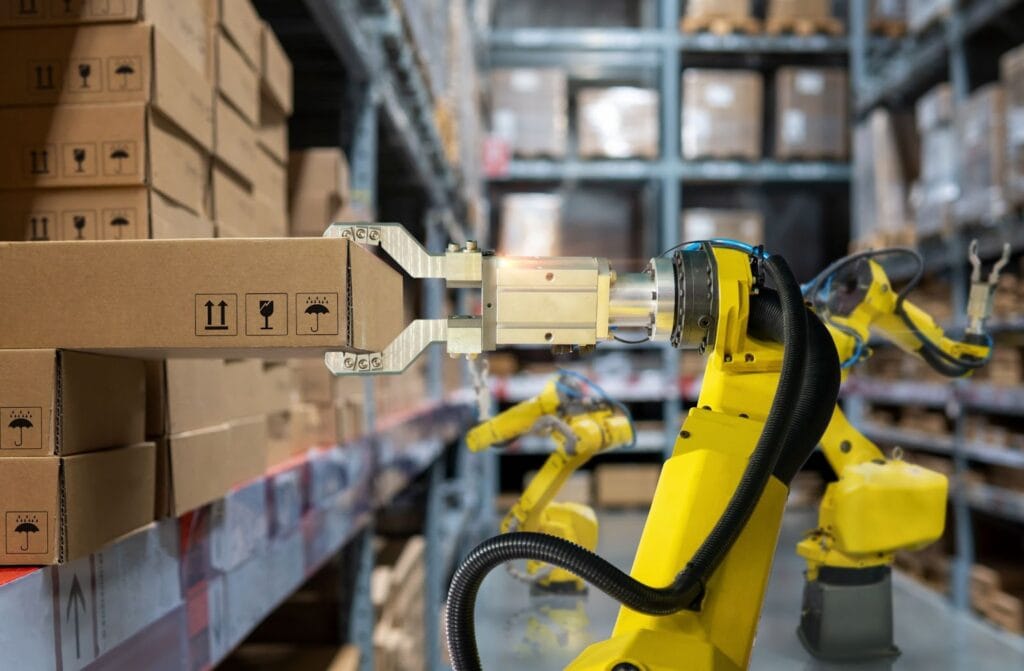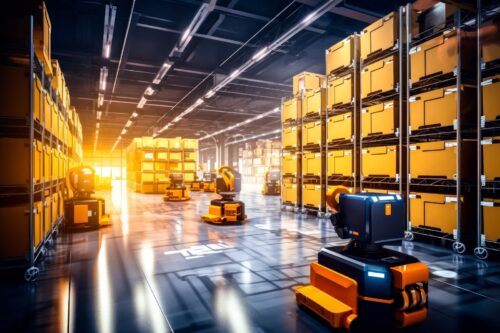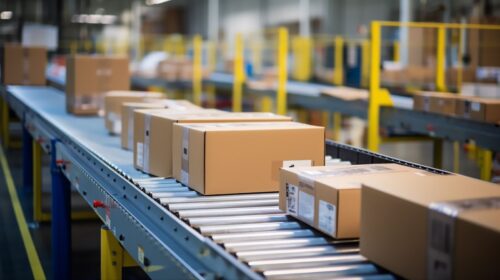Automated Warehouse: Examples, Benefits, and Trends

The automated warehouse is not only a glimpse into the future of logistics but a present reality shaping the supply chain landscape.
According to a study by MHI and Deloitte, 80% of respondents believe the digital, always-on supply chain will be the predominant model within five years.
With the advent of technology, warehouse automation systems are redefining inventory management, order accuracy, and speed of delivery, enhancing customer satisfaction while reducing operational costs.
Automated Warehouse Systems Development
The genesis of automated warehouse systems traces back to the need for efficient, error-free, and fast operations within the logistics industry.
Initially, warehouses were labor-intensive, with workers performing manual tasks often prone to errors and inefficiencies. However, with advancements in technology, the incorporation of automation solutions like Autonomous Mobile Robots (AMRs), automated storage and retrieval systems, and machine learning algorithms have revolutionized warehouse operations.
Today’s automated warehouses are a symphony of cutting-edge technologies that seamlessly streamline inventory, packaging, and delivery processes. Industries ranging from e-commerce to manufacturing are leveraging automation to optimize their supply chains.
For instance, Amazon’s automated warehouse utilizes a mix of robots and AI to streamline its order fulfillment process, leading to reduced delivery times and enhanced customer experience.
The technology embedded in warehouse automation systems ranges from robotics that transport inventory around the warehouse floor to AI algorithms that predict customer demand and optimize inventory management.
They also incorporate integration with existing enterprise software to ensure real-time data analysis and decision making. Vertical lift systems and automated storage solutions maximize warehouse space, ensuring efficient inventory storage and retrieval.
Most Advanced Automated Warehouses Examples
Amazon stands as a quintessential example of warehouse automation at its pinnacle. The e-commerce giant employs over 200,000 mobile robots working alongside human employees to optimize the picking, packing, and shipping processes. These robots reduce the walking time of warehouse workers, increasing efficiency and throughput markedly.
Ocado, a British online supermarket, operates another stellar example of an automated warehouse. In this facility, swarms of robots navigate a three-dimensional grid, picking and packing grocery orders. The system is orchestrated by a complex algorithm that ensures maximum efficiency and speed, resulting in orders being processed in minutes.
Benefits of Automated Warehouse Applications

The application of automated warehouse systems yields many benefits that transcend enhanced operational efficiency, including cost reduction, safety enhancement, and customer satisfaction improvement.
Lower Error Rate
Automation minimizes human intervention, leading to a significant reduction in errors. For example, an automated storage and retrieval system ensures precise picking, reducing the incidence of wrong orders and returns.
Employee Efficacy
Automation relieves employees from repetitive, mundane tasks, allowing them to focus on more complex tasks. In Amazon’s warehouses, robots transport goods, while employees focus on quality checks, enhancing overall efficacy.
Increased Productivity
Automated processes ensure tasks are completed faster and more accurately, leading to increased productivity. Alibaba’s automated warehouse in China utilizes robots to handle 70% of the work, leading to unprecedented efficiency.
Automated processes like real-time inventory tracking and order picking are faster and more accurate, reducing errors and associated costs. Automation also ensures a seamless fulfillment process, from order receipt to packaging and shipping, thus reducing lead times and enhancing customer satisfaction.
Reduced Processing Time
Automation accelerates order processing. In Ocado’s automated warehouse, complex algorithms and robots ensure orders are processed in minutes, ensuring faster customer deliveries.
Maximized Space
Automated storage solutions optimize warehouse space utilization. IKEA’s automated warehouses use robotic carousels to store and retrieve items, maximizing vertical space usage.
Safe and Dependable Operation
Robotic systems ensure operations are conducted safely and reliably. In Amazon’s facilities, robots are equipped with sensors to avoid collisions and ensure a safe working environment.
Improved Inventory Management
Real-time inventory data and AI algorithms optimize stock levels and reordering. Walmart uses AI to analyze sales data and replenish inventory efficiently.
Using AI in inventory management also aids in demand forecasting, ensuring that stock levels are optimized to meet customer demand without excess. Advanced data analytics tools analyze past sales data, trends, and other factors to predict future demand, aiding warehouse managers in making informed decisions on inventory purchases and stock allocation.
Reduced Operational Costs
Automation reduces labor and operational costs. Companies like Amazon leverage robotics and AI to streamline operations, significantly cutting costs.
Improved Customer Satisfaction
Automation ensures faster, error-free deliveries. E-commerce giants like Amazon and Alibaba leverage automation to enhance order accuracy and speed of delivery, leading to improved customer satisfaction.
Sustainability and Scalability
Automation is energy-efficient and easily scalable to meet increased customer demand. Ocado’s energy-efficient robots and scalable automated storage and retrieval systems exemplify this, ensuring adaptability to fluctuating market demands.
Disadvantages and Costs of Warehouse Automation
While the advantages of an automated warehouse are evident, it is crucial to consider the associated challenges and costs. Implementing warehouse automation systems involves initial investment hurdles, training requirements, and other operational adjustments.
Initial Start-Up Cost
Implementing warehouse automation can be capital-intensive. The investment in technology, machinery, and integration with existing systems can be substantial. For example, a small e-commerce business might find the initial investment in robotics and AI beyond its immediate financial capability.
The initial start-up cost can be mitigated by phased implementation. Businesses can begin with automating core warehouse tasks and gradually expand to incorporate more complex automation solutions. The adaptability of many warehouse automation systems allows for this phased integration, making automation accessible even for businesses with limited initial capital.
Training
Employees must be trained to operate and manage the new automated systems effectively. In Amazon’s case, despite automation, human intervention is necessary for maintenance, supervision, and other specialized tasks, requiring comprehensive training programs.
Other Considerations
Automation often leads to workforce reductions and necessitates strategic planning for the existing workforce. Also, constant maintenance and upgrades of the automated systems are essential. For instance, an automated storage and retrieval system requires regular maintenance to ensure optimal performance.
Automated Warehouse Operations

The evolution of automated warehouse operations ranges from complete to partial automation, depending on the nature and scale of the business. In complex warehouses like Amazon’s, a combination of robots, AI, and human intervention ensures efficiency, while smaller enterprises might opt for semi-automated solutions to balance costs and efficiency.
Automated Product Receipt
Automation in product receipt enhances accuracy and efficiency. For instance, Walmart utilizes automated systems to receive products, where barcodes are scanned automatically, ensuring precise inventory data entry and immediate shelving or storage application processes.
Automated Transportation Internal
Internal transportation is another area where automation plays a crucial role. Companies like Alibaba employ robots that move products within the warehouse efficiently, reducing manual labor and ensuring that products are transported to their respective storage locations or picking stations in record time.
These robots are equipped with sensors and sophisticated navigation systems, ensuring they follow the most efficient routes within the warehouse. This not only speeds up internal transportation but also reduces fuel consumption and wear and tear on the equipment, contributing to reduced operational costs and an eco-friendly warehouse operation.
Storage Application and Stacker Cranes
Automation in storage optimizes space and enhances retrieval efficiency. IKEA, for instance, employs automated stacker cranes in its warehouses that ensure optimal space utilization and guarantee swift and accurate retrieval of items based on real-time inventory data.
Automated Order Picking and Distribution
Automation in order picking and distribution is pivotal in meeting customer expectations for speed and accuracy. Amazon employs a mix of robots and AI to ensure that the right products are picked, packaged, and shipped efficiently, significantly reducing the order-to-delivery time.
Automated Warehouse Software
Automated warehouse software integrates with physical automation to optimize operations. For instance, SAP Extended Warehouse Management provides real-time data and process automation, enhancing warehouse operations’ visibility, control, and optimization.
This software ensures that all processes, from receipt to shipment, are streamlined, and decision-makers have real-time data at their fingertips to optimize operations.
Safe and Sound Supply Chain
Integrating physical automation and sophisticated software ensures a synergy that redefines efficiency, accuracy, and customer satisfaction in the landscape of automated warehouse operations.
As technology continues to evolve, the scale and scope of automation in warehouse operations are set to reach unprecedented heights, with AI, machine learning, and robotics leading the charge.
The investment in warehouse automation—though significant—is justified by the unparalleled operational efficiency, cost reduction, and customer satisfaction it delivers, positioning it as an indispensable element in the future of supply chain management.
Transitioning to Automation Trends
Businesses considering the transition to an automated warehouse must weigh factors like operational scale, budget constraints, and the complexity of tasks.
The shift is not binary and companies can opt for incremental implementation, blending manual processes and automated solutions. A tailored approach, often integrating various automation technologies, can address specific operational challenges while ensuring ROI.
When transitioning, companies should also consider integrating with their existing enterprise software to ensure a smooth flow of data and processes.
Employee training and change management are pivotal to harness the full potential of the new automated systems. Businesses need to assess their current workforce’s skills and readiness for the transition, providing training and support to ensure that employees are equipped to maximize the benefits of automation technologies.
FAQs
Explore the answers to some frequently asked questions about warehouse automation.
What is a warehouse automation company?
A company that specializes in implementing technology and systems to automate warehouse tasks, increasing efficiency and accuracy in storage, retrieval, and distribution.
Will Amazon warehouses be automated?
Amazon is progressively automating its warehouses, incorporating robots, AI, and other technologies to enhance efficiency and speed while still requiring human oversight.
What is an example of warehouse automation?
Autonomous mobile robots for transporting goods within the warehouse, automated storage and retrieval systems, and AI for inventory management are examples of automation.
How many warehouses are automated?
The number is continually growing, driven by e-commerce demand, technology advancements, and the need for efficiency and speed in supply chain operations.
Warehouse Automation Solutions Summary
The integration of warehouse automation is transforming the logistics industry, offering solutions that enhance efficiency, accuracy, and cost-effectiveness. Automated warehouses leverage cutting-edge technology, reducing labor costs and optimizing processes, setting a new standard for supply chain management in an increasingly competitive and demand-driven marketplace.
As we peer into the future, the synergy between human expertise and automation will continue to shape the supply chain. The iterative improvements in warehouse automation systems, fueled by advancements in AI, robotics, and machine learning, promise an era where supply chain efficiency, speed, and accuracy are optimized to unprecedented levels.
The automated warehouse is not a static concept but an evolving entity, adaptable and scalable to the dynamic shifts in market demands, technology, and consumer expectations.
